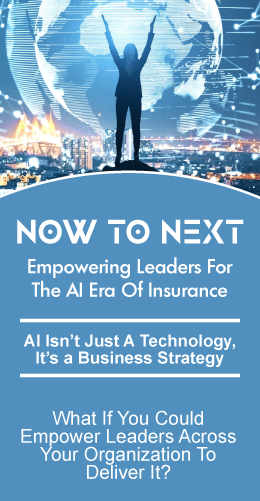
Insurance has always been data-driven. It’s also one of the industries leading the race to adopt AI. And, AI in all its different forms is coming fast. It will impact every part of the insurance industry’s value chains. How we reach customers, engage with them, assess and price risk, manage policies, handle claims and fraud will all be impacted. Beyond that, it will also impact how we measure and manage internal operations as well as distribution channel partners, and how we define and manage products. To stay competitive in this race, Insurers need to rethink and realign current data, analytics, and AI initiatives with the future that’s coming.
A Smarter Insurance Future is Coming Faster and Slower Than You Think
According to Accenture and other researchers, the majority of insurance execs believe that data, analytics, and AI will have the greatest impact on the industry over the next 3 years. They expect the greatest impact on customer engagement and operations. Banks and Insurance companies expect an 86% increase in AI investment by 2025.
That shouldn’t be a surprise. AI adoption is growing by 25% year over year according to Mckinsey. AI is also maturing at an amazing pace. More than $13.5 Billion has been invested in 2019 in startups bringing new capabilities to market. Fast forward 3 – 5 years. How will these capabilities reshape insurance customers and their requirements? How will they reshape the insurance industry? And, perhaps most importantly, how do insurers align their current transformation initiatives now to make sure they are ready to compete in the Data-Driven, AI-powered future?
Personal and business insurance customers are also being changed rapidly by these same technologies. Technologies that will help them become far smarter and efficient at how they manage their lives, businesses, and risks. That experience and capability will dramatically change their expectations and requirements of their insurer partners.
That said, even as executives from multiple industries including insurance are increasing their investments they are also being pragmatic in their outlook. They believe it will take time to achieve the value they would like to receive from those investments. They are also concerned that skilled people are becoming increasingly hard to come by slowing their ability to incorporate it more deeply in their business. What the leaders are doing despite that is continuing to invest.
Immediate Challenges
There are lots of surveys and real-world examples that speak to challenges. Harnessing the power of data, analytics, and AI doesn’t come easy. Getting your data straightened out is just the beginning. Defining the project goals and outcomes, identifying and or acquiring the data, attributing the data, making sure you have enough to be valuable, and cleaning it up are all steps most companies need to work through. And, Digitization of processes is key, without that it’s difficult for AI to make a solid contribution.
Identifying the business processes and the functions within them that will benefit the most from AI is another key challenge point. Establishing a common set of objectives and measurements across stakeholders is also a challenge. Building models isn’t easy, it takes well-attributed data in sufficient quantities to be able to train models. Also, gaining the trust of the organizations that will be using the solutions isn’t always easy. As with any emerging technology getting it right is hard, it takes trial and error, something many organizations have little patience for.
Immediate Requirements
Despite those challenges, industry adoption of analytics and AI in its multiple forms is accelerating. The companies who have committed to it are climbing the learning curve and are building competitive advantage initiative by initiative across the insurance value chain. Each deployment increases their organizational knowledge, deepens their skill sets, and further accelerates their digital advantage. If you plan on remaining competitive in the next 3 – 5 years, your company must be on this path.
Small steps pay off in actual business value and in building the organizational capability and culture to compete. Make an investment in assessing your current transformation initiatives. Determine which could be improved by increased accuracy and speed that also have a fair amount of data associated with them. Break them down into the processes that drive them and look for low hanging fruit. Which initiative candidates represent reasonably well-defined problems and processes that if improved would generate a measurable business impact? If you don’t yet have the skills internally, reach out to consulting firms that do. Have them help you refine your assessment and define some initial POCs with clear measurable business outcomes.
As you deliver and then scale these to production level deployments, your organization will begin to better understand and trust the ability of these technologies to deliver business results. Invest in cleaning up and structuring your existing data and augmenting it where appropriate. As you do think about what other processes this data could support and make sure you are undertaking this work with that larger picture in mind.
Future Business Requirements
COVID has accelerated the world’s adoption of digital capabilities by at least 5 years. While customer engagement, transactions, and remote working are the areas that have most immediately and visibly impacted much more is happening. The next wave of technologies and the business models they enable is also being accelerated as companies look for ways to reignite growth and address new opportunities in the new digital normal.
The development of business models and processes that take advantage of the digital ecosystems and platforms and the ease of integration offered by cloud computing are being accelerated by large companies and startups. Insurance is no exception.
Future AI-Related Technology Drivers
The AI-related technologies on the Gartner Hype curve are also being matured at a faster rate. Companies are rushing to invest in and improve them to capitalize on a universal sense of digital urgency.
Insight engines that pull together, organize and contextually deliver insight from disparate data sources, AI-based cloud services, Graph databases, and knowledge graphs that intelligently link data within specific domains making it easier to build multiple applications and provide guidance and knowledge adding another component to the world of expert systems. Computer Vision and Applications and platforms natively augmented with AI. Services that automatically label data, Edge AI that pushes AI into devices and the applications within them that accelerate AI processes and outputs by taking the load off the network and cloud-based processing. Platforms that can create synthetic data to develop and train AI’s are also being matured. Additionally, work is being done to make AI work effectively with smaller data sets.
These are just a few of the AI-related technologies that are being pushed forward. Insurance companies must develop a longer-term strategic vision for how these advanced technologies will impact their customers both on the personal and business sides of the market. Then they must also develop a vision and scenarios for how these advanced technologies will reshape insurance. Those must be included in how short term projects are defined and implemented so that those initial projects can become stepping stones to the future rather than obsolete islands.
Interweaving Short Term Initiatives with Longer-Term Scenarios
Data
Cleaning up, augmenting, attributing, and structuring structured and unstructured data is job one. Prioritize and focus that work on today’s easy wins, customer engagement, underwriting, and claims. Make sure you have included next-gen data models and cloud-based architectures in your requirements as well as the ability to easily flow data across the organization and between partners. If you are moving to hybrid or cloud-native core systems, make sure they are capable of working with next-gen data models and processes.
Future Customer Scenarios
Whether you are in personal, commercial, or life business lines you need to develop scenarios that include the democratization of these emerging AI-related technologies within the personal and business lives of your customers. Major ecosystem, platform, and application players will be incorporating these into their offerings. They will also be making it easier for their digital partners to access and leverage them. Device manufactures will be embedding some of these capabilities. Smart home, factory, city, and transportation solution providers will be incorporating them as will the large search engines and shopping sites. Manufacturing and supply chain 4.0 will be incorporating them as well as cybersecurity solution providers.
So the design and architecture question you need to ask is how will having these capabilities, this level of intelligence, embedded in the devices, and the personal and business processes of your customers change things? How will it impact their needs and expectations as well as how they select their insurance coverage and providers?
How will the intelligent processes and data coming from the ecosystems, platforms, applications, and devices your customers are interacting with enable you to create breakthrough value for them and increase the effectiveness by which you deliver that value? You must set aside some time as you define your initial initiatives to include these scenarios. They don’t have to be perfect, and they can’t be, but what they will give you is some insight into what your future roadmap is likely to look like. And that gives you the ability to not paint yourself into a corner with the applications you implement or the partners you choose. It will also tell you what kind of future talent and partners you need to be looking for as well as what your organizational structure will need to be.
Bringing it Back to Today’s Initiatives
Walkthrough your existing initiatives. Digital Generation Product Models, Customer Engagement, Underwriting, Claims, Policy Management, and Operational Applications. Ask how these are likely to change based on the scenarios you have defined for customers and the capabilities these emerging technologies will provide your internal systems. Now you have a model you can use to get initial initiatives underway and a roadmap to the future. That will put you decidedly ahead of the pack and reduce the number of pit stops you need to stay ahead of the accelerating digital race.
Love to hear your thoughts.







